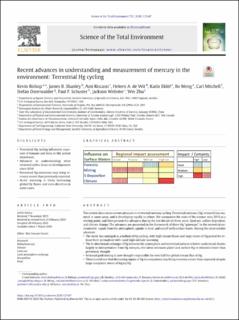| dc.contributor.author | Bishop, Kevin | |
| dc.contributor.author | Shanley, James B. | |
| dc.contributor.author | Riscassi, Ami | |
| dc.contributor.author | de Wit, Heleen | |
| dc.contributor.author | Eklöf, Karin | |
| dc.contributor.author | Meng, Bo | |
| dc.contributor.author | Mitchell, Carl | |
| dc.contributor.author | Osterwalder, Stefan | |
| dc.contributor.author | Schuster, Paul F. | |
| dc.contributor.author | Webster, Jackson | |
| dc.contributor.author | Zhu, Wei | |
| dc.date.accessioned | 2020-09-18T08:04:07Z | |
| dc.date.available | 2020-09-18T08:04:07Z | |
| dc.date.created | 2020-09-06T14:49:32Z | |
| dc.date.issued | 2020 | |
| dc.identifier.citation | Science of the Total Environment. 2020, 721, 137647. | en_US |
| dc.identifier.issn | 0048-9697 | |
| dc.identifier.uri | https://hdl.handle.net/11250/2678393 | |
| dc.description.abstract | This review documents recent advances in terrestrial mercury cycling. Terrestrial mercury (Hg) research has matured in some areas, and is developing rapidly in others. We summarize the state of the science circa 2010 as a starting point, and then present the advances during the last decade in three areas: land use, sulfate deposition, and climate change. The advances are presented in the framework of three Hg “gateways” to the terrestrial environment: inputs from the atmosphere, uptake in food, and runoff with surface water. Among the most notable advances:• The Arctic has emerged as a hotbed of Hg cycling, with high stream fluxes and large stores of Hg poised for release from permafrost with rapid high-latitude warming. • The bi-directional exchange of Hg between the atmosphere and terrestrial surfaces is better understood, thanks largely to interpretation from Hg isotopes; the latest estimates place land surface Hg re-emission lower than previously thought. • Artisanal gold mining is now thought responsible for over half the global stream flux of Hg. • There is evidence that decreasing inputs of Hg to ecosystems may bring recovery sooner than expected, despite large ecosystem stores of legacy Hg. • Freshly deposited Hg is more likely than stored Hg to methylate and be incorporated in rice. • Topography and hydrological connectivity have emerged as master variables for explaining the disparate response of THg and MeHg to forest harvest and other land disturbance. These and other advances reported here are of value in evaluating the effectiveness of the Minamata Convention on reducing environmental Hg exposure to humans and wildlife. | en_US |
| dc.language.iso | eng | en_US |
| dc.publisher | Elsevier | en_US |
| dc.rights | Attribution-NonCommercial-NoDerivatives 4.0 Internasjonal | * |
| dc.rights.uri | http://creativecommons.org/licenses/by-nc-nd/4.0/deed.no | * |
| dc.title | Recent advances in understanding and measurement of mercury in the environment: Terrestrial Hg cycling | en_US |
| dc.type | Peer reviewed | en_US |
| dc.type | Journal article | en_US |
| dc.description.version | publishedVersion | en_US |
| dc.source.pagenumber | 22 | en_US |
| dc.source.volume | 721 | en_US |
| dc.source.journal | Science of the Total Environment | en_US |
| dc.identifier.doi | 10.1016/j.scitotenv.2020.137647 | |
| dc.identifier.cristin | 1827566 | |
| cristin.ispublished | true | |
| cristin.fulltext | original | |
| cristin.qualitycode | 2 | |

